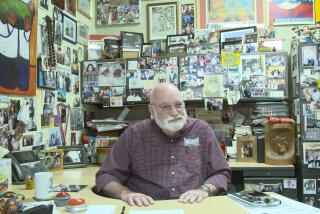Grim Sleeper suspect’s photos of women released
In July, when Los Angeles police arrested Lonnie Franklin Jr., the suspected Grim Sleeper serial killer, they scoured his South L.A. property for evidence. Among the unsettling discoveries was a cache of about 1,000 photographs and hundreds of hours of home video showing women, many of them partly or fully nude and striking sexually graphic poses.
It was an eerie find in a case involving a man who is thought to have sexually assaulted his victims before or after killing them. Police also cannot account for large swaths of Franklin’s life, including a 14-year gap between his alleged killings, during which investigators suspect he killed other women.
PHOTOS: Images found in possession of Grim Sleeper suspect
Detectives set out to identify the women on the film and tape, knowing that some could be additional homicide victims. There were several photos of each woman, and police whittled the collection down to 180 images. They believe that about 20 of the pictures show women also captured in the other photographs.
For months they slogged through images in missing persons databases and coroner records, hoping for lucky matches. The work proved fruitless. With the detectives no closer to identifying the women, police turned to the public Thursday for help. At a news conference, they released cropped versions of the images that show the women’s faces, hoping the women themselves, their family members or acquaintances will recognize them and contact investigators.
Police said they were sensitive to the harm and embarrassment the release of the photographs could cause women who never told their family or friends about the encounters. In the end, however, they decided that the need to identify the women outweighed the potential harm. For similar reasons, the Times has decided to publish the photographs on its website.
“As a police department, we have an obligation to account for the welfare of these women,” said veteran homicide Det. Dennis Kilcoyne, who headed the task force that hunted Franklin. “We’re trying to fill in the life and times of Lonnie Franklin over the past 30 years, and talking to people is a big part of that. These are obviously women who had a conversation or two with this guy.... I won’t be surprised if we find some of them were his victims.”
Police have employed the strategy before in other high-profile serial cases. Most notably, investigators went public earlier this year with a trove of photographs of women and girls taken by killer Rodney James Alcala. But with Alcala’s and some other similar cases, police waited until after the killers had been convicted before releasing images.
LAPD officials decided they could not wait. With little known about Franklin, they hope the women will be able to provide answers that have so far eluded detectives.
“The question of the day is, ‘Why?’ ” Kilcoyne said. ‘What was he doing to get these women to do this sort of stuff on film? Typically, people use drugs as leverage, but we didn’t find one iota of evidence that he was into that.”
Franklin is accused of murdering 10 women and attempting to kill another who survived. Authorities say they have linked Franklin, 58, to the killings through a combination of DNA and ballistics evidence. The former city sanitation worker and LAPD garage attendant has pleaded not guilty and remains in custody.
Louisa Pensanti, Franklin’s attorney, expressed concern about the release of the photographs, saying prosecutors have not yet provided her with copies of the images as part of the legal proceedings. She added that the move will make it difficult for Franklin to receive a fair trial. “I think it’s proper that they try to find out everything they need to, but to do it now, and in this way, will taint the jury pool,” Pensanti said.
The discovery of the photographs came at the end of a long, frustrating search for the killer, whom the LA Weekly dubbed the Grim Sleeper for the long stretch between killings.
The killer’s first known slaying occurred in the summer of 1985, when a 29-year-old woman was shot three times in the chest and her body left in an alley near West Gage Avenue, police said. Three years passed before ballistics tests alerted police that the same handgun used to kill the first woman had been used in seven other killings.
The case went cold until 2004, when DNA testing linked the earlier killings to genetic evidence found on the body of a 14-year-old girl found strangled and beaten in an Inglewood alley in March 2002 and a woman killed in 2003. Then, in January 2007, DNA tests linked the killer to another woman’s slaying.
The killer’s DNA profile did not match any of the millions taken from convicted felons and arrestees that are kept in law enforcement databases. Kilcoyne and half a dozen detectives painstakingly tried to track down prostitutes, drug dealers and pimps who were active in the area during both periods of killings, hoping someone would be able to lead them to the killer. Several tantalizing leads went nowhere.
The break came this summer when a new, controversial form of DNA matching that searched for potential relatives of the killer led detectives to Franklin’s son. Undercover officers trailed Franklin for days until they surreptitiously collected a DNA sample that, police said, tied Franklin to the killings.
Authorities combed his house, as well as a garage, vehicles and a trailer in the backyard, finding most of the photos in the trailer. The people in the images appear to span a wide range of ages, from teenagers to women in their 40s or older. Many of the subjects are smiling. In some, however, the women appear dead, heavily drugged or asleep.
Steve Katz, co-executive producer of the TV show “America’s Most Wanted,” said Thursday that police have long been releasing photos of possible victims of crimes. The reach of the Internet, he said, has made the strategy more effective. “In days gone by, it would be a local story, maybe picked up by the national networks,” Katz said. “It was difficult to get those pictures out in front of a wide audience.”
Last week, police in Albuquerque, N.M., released photographs of seven unidentified women thought to be connected to a serial killer who is linked to the murders of 11 other women.
In 2008, Los Angeles County sheriff’s homicide investigators released pictures of 47 women. The photos had been taken in the 1980s by William Bradford, a professional photographer, who was convicted in 1987 of the slayings of two models. In the two weeks after the release of the images, sheriff’s officials fielded more than 2,000 calls from around the country and Europe. Most of the women or family members confirmed the subjects in the photos were alive, although investigators could not account for about a dozen of them and believe strongly they may have been murdered.
“We’ll never know,” said retired Sheriff’s Capt. Ray Peavy.
In the Alcala case, detectives seized hundreds of images from a storage locker the convicted killer rented, but waited three decades to release them as prosecutors struggled through several trials for a conviction.
Detectives have already fielded a wave of phone calls in the Grim Sleeper case. After Franklin’s arrest, family and friends of about 75 missing women called, wanting to know if he could have been responsible for their disappearances.
Detectives were able to dismiss Franklin as a suspect in most of those cases but are pursuing the possibility that he’s tied to a handful of them, Kilcoyne said.
More to Read
Start your day right
Sign up for Essential California for news, features and recommendations from the L.A. Times and beyond in your inbox six days a week.
You may occasionally receive promotional content from the Los Angeles Times.







